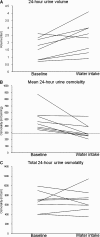Water prescription in autosomal dominant polycystic kidney disease: a pilot study
- PMID: 20876670
- PMCID: PMC3022242
- DOI: 10.2215/CJN.03950510
Water prescription in autosomal dominant polycystic kidney disease: a pilot study
Abstract
Background and objectives: In animal models of polycystic kidney disease, the ingestion of large amounts of water promotes diuresis by suppressing plasma levels of arginine vasopressin (AVP) and renal levels of cAMP, slowing cyst progression. Whether simple water ingestion is a potential therapeutic strategy for individuals with autosomal dominant polycystic kidney disease (ADPKD) is unknown. In this study, a simple method to quantify the amount of water to achieve a specific mean urine osmolality target in patients with ADPKD was developed and tested.
Design, setting, participants, & measurements: In eight ADPKD patients eating typical diets, osmolality and volume were measured in 24-hour urine collections. The amount of additional ingested water required daily to achieve a mean urine osmolality of 285 ± 45 mosm/kg was determined. Participants were instructed to distribute the prescribed water over waking hours for each of 5 days. Blood chemistries, 24-hour urine collections, BP, and weight were measured before and after the period of supplemental water intake.
Results: Five patients achieved the 285 mosm/kg urine target without difficulty. Mean urine osmolality decreased and mean urine volume increased; serum sodium, weight, and BP were unchanged. Daily osmolar excretion remained constant, indicating a stable ad lib dietary intake of solutes and protein over the 2-week study period.
Conclusions: The amount of additional water needed to achieve a urine osmolality target can be approximated from the urine osmolar excretion in ADPKD patients eating typical diets, providing a quantitative method to prescribe supplemental water for such individuals.
Trial registration: ClinicalTrials.gov NCT00759369.
Figures


References
-
- Grantham JJ, Chapman AB, Torres VE: Volume progression in autosomal dominant polycystic kidney disease: The major factor determining clinical outcomes. Clin J Am Soc Nephrol 1: 148–157, 2006 - PubMed
-
- Grantham JJ: Lillian Jean Kaplan International Prize for advancement in the understanding of polycystic kidney disease. Understanding polycystic kidney disease: A systems biology approach. Kidney Int 64: 1157–1162, 2003 - PubMed
-
- Torres VE, Bankir L, Grantham JJ: A case for water in the treatment of polycystic kidney disease. Clin J Am Soc Nephrol 4: 1140–1150, 2009 - PubMed
-
- Gattone VH, 2nd, Maser RL, Tian C, Rosenberg JM, Branden MG: Developmental expression of urine concentration-associated genes and their altered expression in murine infantile-type polycystic kidney disease. Dev Genet 24: 309–318, 1999 - PubMed
-
- Gattone VH, 2nd, Wang X, Harris PC, Torres VE: Inhibition of renal cystic disease development and progression by a vasopressin V2 receptor antagonist. Nat Med 9: 1323–1326, 2003 - PubMed
Publication types
MeSH terms
Substances
Associated data
LinkOut - more resources
Full Text Sources
Medical
Miscellaneous

